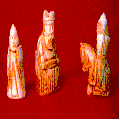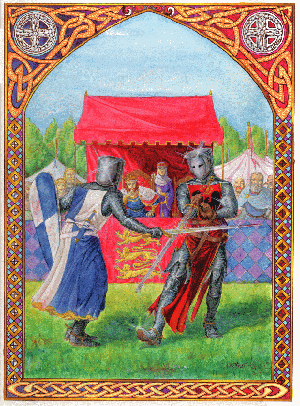






![]() n the General Prologue of The Canterbury Tales, the narrator, Geoffrey Chaucer, meets twenty nine pilgrims at the Southwark at the Tabard Inn. They are all going to Canterbury Cathedral to visit the shrine of Sir Thomas Becket. Chaucer decides to tag along, taking some time to describe each pilgrim. The author uses many metaphors, personal histories, and examples of how they would act in certain situations to fully describe the characters in the story. However, some of the pilgrims are given only a few lines of direct description in a very straightforward, visual manner. One of the characters in the tales is Squire, who gets only twenty lines of details, focusing on his appearance, his abilities, and his sexuality.
n the General Prologue of The Canterbury Tales, the narrator, Geoffrey Chaucer, meets twenty nine pilgrims at the Southwark at the Tabard Inn. They are all going to Canterbury Cathedral to visit the shrine of Sir Thomas Becket. Chaucer decides to tag along, taking some time to describe each pilgrim. The author uses many metaphors, personal histories, and examples of how they would act in certain situations to fully describe the characters in the story. However, some of the pilgrims are given only a few lines of direct description in a very straightforward, visual manner. One of the characters in the tales is Squire, who gets only twenty lines of details, focusing on his appearance, his abilities, and his sexuality.
![]() he physical description of the Squire illustrates him as if he was a Roman statue, or taken from a chivalric romance. Chaucer describes his " lokkes crulle as they were leyd in presse"(Norton, 83), average height, great strength, "Of twenty yeer of age he was" (Norton, 83), bravery and cleverness. The author illustrates Squire's youth "as fressh as is the month of may." (Norton, 83). The dress of the squire is colorful, embroidered with flowers, short with large sleeves. He is very talented, too. Chaucer dedicates some lines in the poem to the squire's skills - horsemanship, jousting, sketching, dancing, song and verse writing: "Wel koude he sitte on hors and faire ryde./ He koude songes make and wel endite,/ Juste and eek daunce, and weel purtreye and write." (Norton, 83).
he physical description of the Squire illustrates him as if he was a Roman statue, or taken from a chivalric romance. Chaucer describes his " lokkes crulle as they were leyd in presse"(Norton, 83), average height, great strength, "Of twenty yeer of age he was" (Norton, 83), bravery and cleverness. The author illustrates Squire's youth "as fressh as is the month of may." (Norton, 83). The dress of the squire is colorful, embroidered with flowers, short with large sleeves. He is very talented, too. Chaucer dedicates some lines in the poem to the squire's skills - horsemanship, jousting, sketching, dancing, song and verse writing: "Wel koude he sitte on hors and faire ryde./ He koude songes make and wel endite,/ Juste and eek daunce, and weel purtreye and write." (Norton, 83).

![]() he physical illustration of Squire is carefully surrounded by sexual references. The author tells us in his poem that the young character is "a lovere and a lusty bacheler"(Norton, 83), who loves so hotly that he sleeps at night "namoore than dooth a nyghtyngale"(Norton, 83). Chaucer uses meadows, fresh flowers, and squire's songs as the methphors to represent the character's sexual image that hides under the portrait of the candidate for a knight. Chaucer also refers to the object of squire's chivalry, his lady.
he physical illustration of Squire is carefully surrounded by sexual references. The author tells us in his poem that the young character is "a lovere and a lusty bacheler"(Norton, 83), who loves so hotly that he sleeps at night "namoore than dooth a nyghtyngale"(Norton, 83). Chaucer uses meadows, fresh flowers, and squire's songs as the methphors to represent the character's sexual image that hides under the portrait of the candidate for a knight. Chaucer also refers to the object of squire's chivalry, his lady.
![]() he strange thing about Squire's sexuality and his character as a whole is its neutrality. He is illustrated as powerful and effective young knight. It seems however that he is lifeless, like a stone or still statue. The squire's physical characteristics strongly hit the reader's mind, yet not much is understood about Squire. Chaucer even portrays him in a morally neutral manner, he leaves the judgement of the squire to the reader. The squire is a victim of Chaucer's prejudice portraits, where some characters get detailed representation while others get brief, basic treatment.
he strange thing about Squire's sexuality and his character as a whole is its neutrality. He is illustrated as powerful and effective young knight. It seems however that he is lifeless, like a stone or still statue. The squire's physical characteristics strongly hit the reader's mind, yet not much is understood about Squire. Chaucer even portrays him in a morally neutral manner, he leaves the judgement of the squire to the reader. The squire is a victim of Chaucer's prejudice portraits, where some characters get detailed representation while others get brief, basic treatment.
![]() he squire's character is ironically a wonderful example of young men who in the middle ages devoted their lives to become powerful knights. They were suppose to be "the finests" as many policemen are called today. However, it seems that Chaucer also wanted to illustrate the character's another side of personality. This side is the squire's sexuality and trend toward women. As a candidate for a knight, the squire should show his tendency to think about becoming someone very important and honored. The main character, on the other hand, seems to be interested more in things like song writing and sexuality that don't belong in the battle field.
he squire's character is ironically a wonderful example of young men who in the middle ages devoted their lives to become powerful knights. They were suppose to be "the finests" as many policemen are called today. However, it seems that Chaucer also wanted to illustrate the character's another side of personality. This side is the squire's sexuality and trend toward women. As a candidate for a knight, the squire should show his tendency to think about becoming someone very important and honored. The main character, on the other hand, seems to be interested more in things like song writing and sexuality that don't belong in the battle field.

